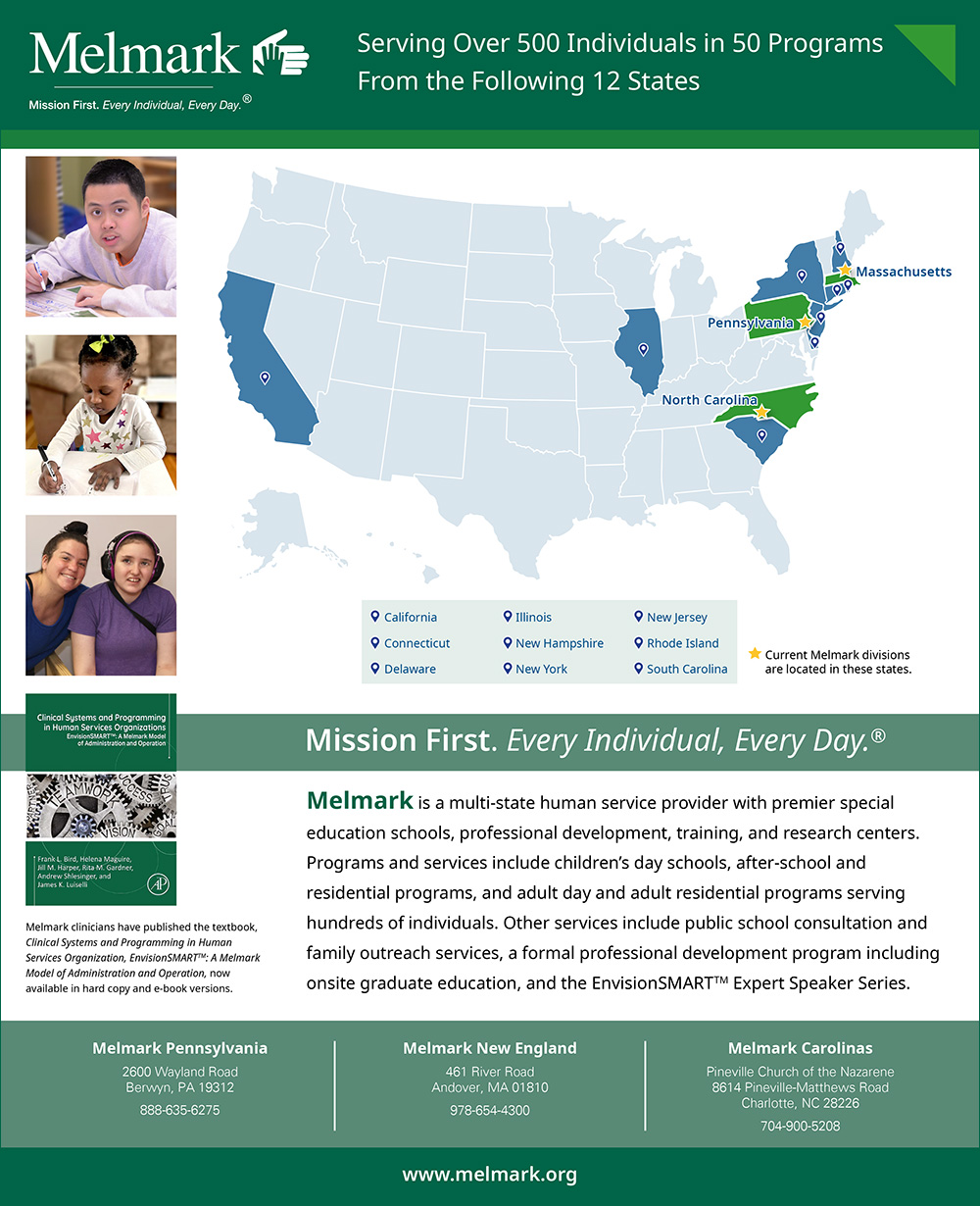While history began documenting autism in children in the early 1900s, it was not until later in the century that autism became recognized as a distinct circumstance. The first generation of children diagnosed with autism is just now moving into older age. With aging brings social, physical, and cognitive health issues as well as the potential challenges of being autistic. Today’s interdisciplinary teams are among the earliest professionals supporting this age group, and as a field, we must commit to setting precedents that can be built upon for generations to come.

The following is the preliminary work and experience of an interdisciplinary team consisting of a behavior analyst, nursing, speech pathologist, occupational therapist, physical therapist, and operational leadership personnel working in an intermediate care facility. Through our experience, it has been critical to have early conversations around end-of-life plans before it becomes too late and the ability to provide compassionate care is compromised. As anyone faces the end of their life, the need to plan for the distant or even near future is often put off or ignored across populations. Often, the pressure and urgency of daily needs leave little energy or resources to plan outside of the present.
The number of adults with intellectual and developmental disabilities over 60 is estimated to grow from about 641,860 as of 2000 to 1.2 million in 2030 (Garcia-Dominguez et al., 2020). In B.F. Skinner’s 1983 lecture, which later led to the novel Enjoy Old Age, he referred to aging as a “special problem, [that is not particularly new], to which little attention has been given.” Decades later, this remains truer than ever, especially for populations with learning differences and those who are differently abled. Because autism is often specifically accompanied by difficulty in communication and social reciprocity, the completion of assessments and delivering needed services can be a challenging undertaking for all involved in the individuals’ care.
We are beginning to identify the differences in the aging experience of our autistic population. Adults with intellectual disabilities are shown to exhibit higher rates of epilepsy, psychosis, hypothyroidism, asthma, diabetes, and heart failure (Cooper et al., 2018). As a field, we need to identify and prioritize long-term care considerations for the people we support, especially for those unable to vocalize their wishes for the end of their lives. It’s easier to start having conversations about a “good death” for someone while the person is healthy. Michael Baron, a founder of the National Autistic Society in the U.K. and parent of a child with autism, describes this in a 2015 post on the blog The Social Issue as “…meaningful conversations that acknowledge the [enduring presence of human rights], even in the absence of legal rights…. No decision should be made which has not already been discussed. [That is the minimum human right to which someone is entitled].”
Regular screening, assessment, documentation, and discussion across interdisciplinary team members and caregivers will allow status changes to be identified and addressed. Funding models typically prescribe formal team reviews at a minimum of annually. Interdisciplinary teams should use these as opportunities to approach and document these decisions earlier in life by identifying the physical, social, psychological, and spiritual wishes of the individual (Ferguson 2016). Caregivers who know an individual well or did in the past play an integral role in identifying someone’s preferences that have difficulty expressing them. In recent years, there has been a positive shift in implementing an individualized approach toward assisting our school-aged individuals to plan proactively for their futures when district-funded services end. The same future planning models must be modified and executed as our adults become even older adults. Normalizing these models may lead to outcomes such as decreased avoidance of making end-of-life decisions and ensuring personalized, compassionate, and effective supports are implemented across the lifespan.
While some individuals experience an acute illness or health event, often, a more gradual change is observed. In one experience, an individual began to decline in communication, hygiene, self-care, and a loss of interest in things the person previously enjoyed. The legal guardian was reluctant to engage in any conversations regarding end-of-life care planning. Unexpectedly, the guardian became ill and passed away. The individual being served continued to decline and, at a point, required emergency medical care. The facility advocated for a hospice consult and to allow the individual to be cared for in their own residence that they had resided in for decades, surrounded by familiar caregivers and peers. Because there was no planning or documentation in place, the hospital was resistant to collaborating with the intermediate care facility to determine the next steps. While some individuals in our care may not have an outwardly evident response, a person is impacted by their changing bodies and the likelihood of stress and worry surrounding them. While the facility was able to eventually advocate for the individual to be released back to their home under the care of hospice, the result included a lengthy hospital stay and a delay in providing the comfortable and compassionate care the individual was entitled to in their final days.
In more recent months, our interdisciplinary team was faced with a similar situation. An individual who had resided in the same residential facility for 49 of their 50 years of life began experiencing a number of medical challenges. The team and family began to discuss end-of-life care. Hospice was consulted, and the plan of care shifted from curative medical treatment to comfort and support. When the individual’s ability to eat diminished, she continued to ask for preferred food and drink items. Caregivers provided bites of applesauce and yogurt paired with sips of juice while allowing her favorite show, the Golden Girls, to play on a loop in the background. The individual passed peacefully in the night with plans in place for who to call and what would happen next.
While the team felt the emotions of the loss for both individuals, having the action steps pre-determined and discussed ahead of time, as with the second individual described, allowed all resources to be directed solely to caring for the individual. Compassionate care was able to be provided in their final days, taking into account their preferences and the family’s wishes. Accessing the voice of the individual always remains the priority, and planning for end-of-life care early on can lead to a better quality of life during the individual’s final days.
Amanda L. Duffy, MEd, BCBA, LBS, is Director of Clinical Services – Adult Programs, Kristina Gasiewski, MOTRL/L, MEd, BCBA, is a Behavior Analyst, and Lara Redcay, MEd, BCBA, is Assistant Director of ICF/IDD at Melmark Pennsylvania.
References
Cooper, S. A., Hughes McCormack, L., Greenlaw, N., McConnachie, A., Allan, L., Baltzer, M., McArthur, L., Henderson, A., Melville, C., McSkimming, P., & Morrison, J. (2017). Management and prevalence of long-term conditions in primary health care for adults with intellectual disabilities compared with the general population: A population-based cohort study. Journal of Applied Research in Intellectual Disabilities, 31, 68-81. https://doi.org/10.1111/jar.12386
Ferguson, J. (2016, May 18). Palliative and end of life care for autistic people. National Autistic Society. www.autism.org.uk/advice-and-guidance/professional-practice/palliative-care
García-Domínguez, L., Navas, P., Verdugo, M. A., & Arias, V. (2020). Chronic Health Conditions in Aging Individuals with Intellectual Disabilities. International Journal of Environmental Research and Public Health, 17(9). doi.org/10.3390/ijerph17093126
Gawande, A. (2014). Being Mortal: Medicine and What Matters in the End. Henry Holt and Company.
National Institute on Aging (2022, November 17). Providing Care and Comfort at the End of Life. Retrieved August 1, 2024, from www.nia.nih.gov/
Oliver, D. (2017), “Peaceful, Pain Free and Dignified: Palliative and End of Life Care for People on the Autism Spectrum. A Guide for Social Care Practitioners”, Tizard Learning Disability Review, 22(1), 51 doi.org/10.1108/TLDR-03-2016-0007
Saba, S. (2015 December 5). Equal Rights at the End of Life for People with Autism The Social Issue.
Skinner, B. (1983). Intellectual Self-Management in Old Age. American Psychologist, 38(3). 239-44. doi.org/10.1037//0003-066x.38.3.239
Skinner, B., & Vaughan, M. (1983). Enjoy Old Age: A Program of Self-Management (1st ed.). Norton and Company.









